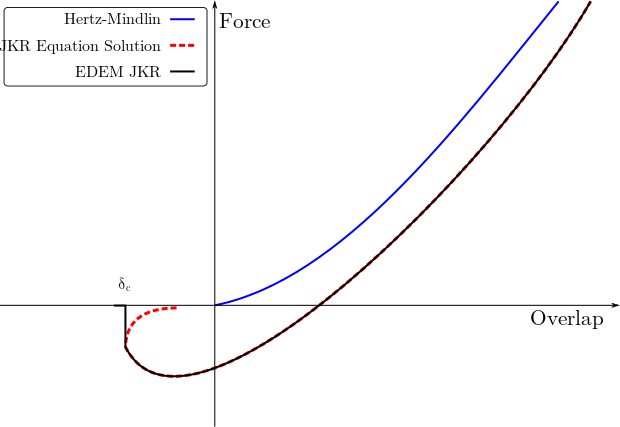The Hertz-Mindlin with JKR contact model works within the contact zone and allows you
to model strongly adhesive systems, such as dry powders or wet materials.
Hertz-Mindlin with JKR (Johnson-Kendall-Roberts) Cohesion is a cohesion contact model
that accounts for the influence of Van der Waals forces. In this model, the
implementation of normal elastic contact force is based on the
Johnson-Kendall-Roberts theory (Johnson, Kendal and
Roberts 1971).
Hertz-Mindlin with JKR Cohesion uses the same calculations as the Hertz-Mindlin (no
slip) contact model for the following types of forces:
- Tangential elastic force
- Normal dissipation force
- Tangential dissipation force
JKR normal force depends on the overlap δ and the interaction parameter, surface
energy γ as follows:
Here, E* is the equivalent Young’s modulus, and R* is the
equivalent radius defined in the Hertz-Mindlin (no slip) Model section.
The normal force is a function of normal overlap. The Hertz-Mindlin with JKR cohesion
model results are compared with the Hertz-Mindlin (no slip) model results. Negative
overlap is the gap between two separated particles.
The EDEM JKR normal force follows the same solution of
the above equations for both loading and unloading phases. The figure shows the
typical plot of JKR normal force as a function of normal overlap.
For γ = 0, force turns into Hertz-Mindlin normal force:
This model provides attractive cohesion forces even if the particles are not in
physical contact. The maximum gap between particles with non-zero force is defined
as:
For δ < δc , the model returns zero force. The maximum value of the
cohesion force occurs when particles are not in physical contact and the separation
gap is less than δc. The value of maximum cohesion force, called pull-out
force, is defined as:
Friction force calculation is different from the Hertz-Mindlin (no slip) model. In
that, it depends on the positive repulsive part of JKR normal force. As a result,
the EDEM JKR Friction model provides greater friction
force when the cohesion component of the contact force is higher. The importance and
advantages of this Friction Force model correction in the presence of strong
cohesive forces was noted and illustrated in (Baran, et al.
2009), (Gilabert, Roux and Castellanos 2007).
Although this model was designed for fine, dry particles, it can be used to model wet
particles. The force needed to separate two particles depends on the liquid surface
tension γc and the wetting angle θ:
Equating the above force to JKR max force allows JKR surface energy parameter
estimation if the EDEM particle size is not scaled.
| Interaction |
Configurable Parameters |
Position |
| Particle to Particle, Particle to Geometry. |
Click + to add cohesion to
particle-particle or particle-geometry interactions. Set the
surface energy for each interaction. Surface energy is a
property of the materials ability to retain moisture/charge on
its surface. The amount of surface energy influences the
adhesion of the material. The SI units of surface energy are
J/m². |
Last |
- In the Creator Tree, select Physics.
- Select the required interaction from the Interaction
dropdown list.
- Click the + icon and then select
Hertz-Mindlin with JKR Cohesion.
- Click the
 icon to define the contact model
parameters.
icon to define the contact model
parameters.
Note: It is not recommended to use this contact model with
particle contact radius 'ON' since this will result in an attractive force
before a physical contact is made (see the
Hertz-Mindlin with
JKR Version 2 model).

 icon to define the contact model
parameters.
icon to define the contact model
parameters.